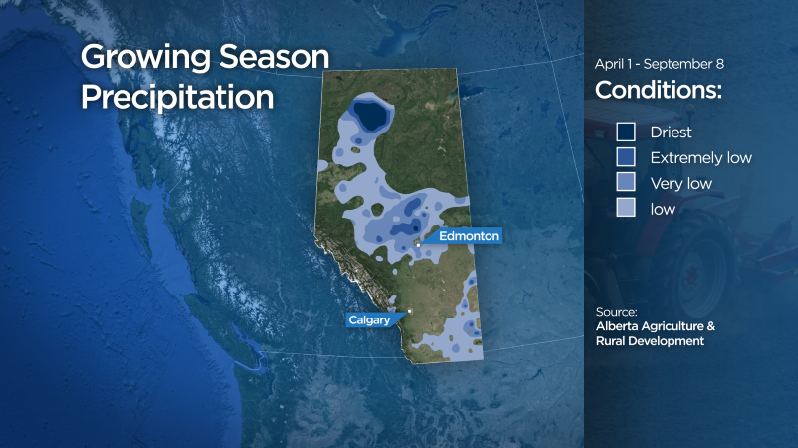EDMONTON — Drive through many parts of central Alberta, and the drought of 2015 is visible. Multi-coloured crops comprised of mature and new growth are a result of the dry growing season.

It’s been cause for concern for Alberta grain farmers — after all, they produce almost half of the $4.1 billion worth of wheat and canola exports in Canada.
“Timing of harvest is hard to do this year,” said Humphrey Banack, who farms over 7,000 acres of land in central Alberta.
“We put in 13 to 14 seeds per square foot and we might have got two or three to grow right off the bat,” Banack explained from his patchy looking fields just north of Camrose. “And as the rain came later, showers through June and July, we started to see more come, so it’s given us a very varied end product.”
“You’ll see some fields that look very ripe as you drive out here, and you’ll see these green patches. That’s the second growth that came in July, and that is what is going to be very hard to manage because it still has a long time to harvest, whereas the first stuff is already there – so which one do you go out to get?”
The variable maturity is not great for crop quality, but patchy is promising. After all, most of central Alberta saw drought conditions that occur only once every 25 to 50 years — and harvest expectations were low.
READ MORE: Soil moisture levels in central Alberta at 50-year low
As progress is being made on harvest, a sense of relief is widespred. The latest crop reports show that yield quantities are expected to be 75 to 85 per cent of the five-year normals.
Harry Brook is a crop specialist for Alberta Agriculture and says that while there are municipal states of agricultural disaster this year – for grain farmers, it’s more of a disappointment.
“You’ve got people with really good yields, people with pretty poor yields, and people who are surprised that it’s better than it looked,” Brook explained.
He says the real disaster is for the livestock producers.
“The real impact of this year’s weather is mostly on livestock and the availability of feed. It tends to be fairly high priced, and in some areas, in short supply,” he continued.
Grain quantity for this year’s harvest is not as dire as originally thought, but heavy September rain has hampered the harvest progress.
“The rains now will be hurting our wheat grades and quality, and we could see substantial losses, up to $18-20 an acre when we go from top grade milling wheats to the mid grade milling wheats,” Banack continued from his field.
So while farmers were once praying for rain – they now need it to stop. They’re hoping for dry and mild conditions over the next few weeks in order to preserve what value remains.


Comments